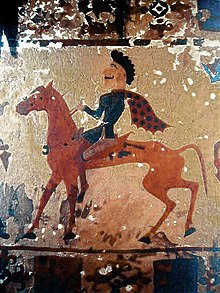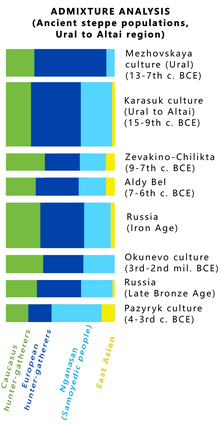Pazyryk culture
| Geographical range | South Siberia |
|---|---|
| Dates | 6th to 3rd centuries BC |




The Pazyryk culture (Russian: Пазырыкская культура Pazyrykskaya kul'tura) is a Scythian[3] nomadic Iron Age archaeological culture (6th to 3rd centuries BC) identified by excavated artifacts and mummified humans found in the Siberian permafrost, in the Altay Mountains, Kazakhstan and nearby Mongolia. The mummies are buried in long barrows (or kurgans) similar to the tomb mounds of Scythian culture in Ukraine. The type site are the Pazyryk burials of the Ukok Plateau.[4] Many artifacts and human remains have been found at this location, including the Siberian Ice Princess, indicating a flourishing culture at this location that benefited from the many trade routes and caravans of merchants passing through the area.[5] The Pazyryk are considered to have had a war-like life.[6]
Archaeology[]
Other kurgan cemeteries associated with the culture include those of , , , and Berel. There are so far no known sites of settlements associated with the burials, suggesting a purely nomadic lifestyle.
Because of a freak climatic freeze, some of the Altai burials, notably those of the 5th century BC at Pazyryk and neighbouring sites, such as Katanda, , and , were isolated from external climatic variations by a protective layer of ice that conserved the organic substances buried in them. At Pazyryk these included the bodies of horses and an embalmed man whose body was covered with tattoos of animal motifs. The remarkable textiles recovered from the Pazyryk burials include the oldest woollen knotted-pile carpet known, the oldest embroidered Chinese silk, and two pieces of woven Persian fabric (State Hermitage Museum, St. Petersburg). Red and ochre predominate in the carpet, the main design of which is of riders, stags, and griffins. Many of the Pazyryk felt hangings, saddlecloths, and cushions were covered with elaborate designs executed in appliqué feltwork, dyed furs, and embroidery. Of exceptional interest are those with animal and human figural compositions, the most notable of which are the repeat design of an investiture scene on a felt hanging and that of a semihuman, semibird creature on another (both in the State Hermitage Museum, St. Petersburg). Clothing, whether of felt, leather, or fur, was also lavishly ornamented.
Horse reins either had animal designs cut out on them or were studded with wooden ones covered in gold foil. Their tail sheaths were ornamented, as were their headpieces and breastpieces. Some horses were provided with leather or felt masks made to resemble animals, with stag antlers or rams’ horns often incorporated in them. Many of the trappings took the form of iron, bronze, and gilt wood animal motifs either applied or suspended from them; and bits had animal-shaped terminal ornaments. Altai-Sayan animals frequently display muscles delineated with dot and comma markings, a formal convention that may have derived from appliqué needlework. Such markings are sometimes included in Assyrian, Achaemenian, and even Urartian animal representations of the ancient Middle East. Roundels containing a dot serve the same purpose on the stag and other animal renderings executed by contemporary Śaka metalworkers. Animal processions of the Assyro-Achaemenian type also appealed to many Central Asian tribesmen and are featured in their arts.
Certain geometric designs and sun symbols, such as the circle and rosette, recur at Pazyryk but are completely outnumbered by animal motifs. The stag and its relatives figure as prominently as in Altai-Sayan. Combat scenes between carnivores and herbivores are exceedingly numerous in Pazyryk work; the Pazyryk beasts are locked in such bitter fights that the victim's hindquarters become inverted.[7]
DNA analysis[]
DNA samples recovered from the remains of Pazyryk males showed them to be belonged to clades of haplogroup R1a1.[8][9] with only two Pazyryk males were members of Y-chromosome haplogroup N1b-P43.[10] In the related cultures such as Aldy-Bel culture and Sagly culture of the Altai region, haplogroup Q-L54 samples(6/17) were also found in kurgans.[11] Autosomal genetic analysis of Pazyryk remains found that the samples were of predominant Paleo-Siberian and Nganasan-related component, over a European hunter-gatherer substrate.[12]
See also[]
References[]
Citations[]
- ^ Bunker, Emma C. (2002). Nomadic Art of the Eastern Eurasian Steppes: The Eugene V. Thaw and Other Notable New York Collections. Metropolitan Museum of Art. pp. 27–28.
- ^ Unterländer, Martina; Palstra, Friso; Lazaridis, Iosif; Pilipenko, Aleksandr; Hofmanová, Zuzana; Groß, Melanie; Sell, Christian; Blöcher, Jens; Kirsanow, Karola; Rohland, Nadin; Rieger, Benjamin (2017-03-03). "Ancestry and demography and descendants of Iron Age nomads of the Eurasian Steppe". Nature Communications. 8: Figure 7. doi:10.1038/ncomms14615. ISSN 2041-1723. PMC 5337992. PMID 28256537.
- ^ The Editors (2001-09-11). "Pazyryk | archaeological site, Kazakhstan". Britannica.com. Retrieved 2019-03-05.
{{cite web}}:|author=has generic name (help) - ^ (NOVA 2007)
- ^ (State Hermitage Museum 2007)
- ^ (Jordana 2009)
- ^ "Altaic Tribes". Encyclopædia Britannica Online. Encyclopædia Britannica. Retrieved December 5, 2016.
- ^ Unterländer, Martina (2017). "Ancestry and demography and descendants of Iron Age nomads of the Eurasian Steppe". Nature Communications. 8: 14615. doi:10.1038/ncomms14615. PMC 5337992. PMID 28256537.
- ^ Ricaut, F.; et al. (2004). "Genetic Analysis of a Scytho-Siberian Skeleton and Its Implications for Ancient Central Asian Migrations". Human Biology. 76 (1): 109–25. doi:10.1353/hub.2004.0025. PMID 15222683. S2CID 35948291.
- ^ Pilipenko A. S., Trapezov R. O., Polosmak N. V. A PALEOGENETIC STUDY OF PAZYRYK PEOPLE BURIED AT AK-ALAKHA-1, THE ALTAI MOUNTAINS in Russian, 2015-12-21.
- ^ Mary, Laura (March 28, 2019). "Genetic kinship and admixture in Iron Age Scytho-Siberians". Human Genetics. 138 (4): 411–423. doi:10.1007/s00439-019-02002-y. PMID 30923892
- ^ Unterländer, Martina; Palstra, Friso; Lazaridis, Iosif; Pilipenko, Aleksandr; Hofmanová, Zuzana; Groß, Melanie; Sell, Christian; Blöcher, Jens; Kirsanow, Karola; Rohland, Nadin; Rieger, Benjamin (2017-03-03). "Ancestry and demography and descendants of Iron Age nomads of the Eurasian Steppe". Nature Communications. 8: 14615. doi:10.1038/ncomms14615. ISSN 2041-1723. PMC 5337992. PMID 28256537.
Sources[]
- Jordana, Xavier (2009). "The warriors of the steppes: osteological evidence of warfare and violence from Pazyryk tumuli in the Mongolian Altai". Journal of Archaeological Science. 36 (7): 1319–1327. doi:10.1016/j.jas.2009.01.008.
- NOVA (2007). "Ice Mummies: Siberian Ice Maiden". PBS - NOVA. Retrieved 2007-07-31.
- State Hermitage Museum (2007). "Prehistoric Art - Early Nomads of the Altaic Region". The Hermitage Museum. Archived from the original on 2007-06-22. Retrieved 2007-07-31.
- Сергей Иванович Руденко (Sergei I. Rudenko) (1970). Frozen Tombs of Siberia: The Pazyryk Burials of Iron Age Horsemen. University of California Press. ISBN 978-0520013957.
External links[]
| Wikimedia Commons has media related to Pazyryk culture. |
- Nomadic Art of the Eastern Eurasian Steppes, an exhibition catalog from The Metropolitan Museum of Art (fully available online as PDF), which contains material on Pazyryk culture
- Archaeological cultures of Siberia
- Archaeological sites in Russia
- Animals in art
- Nomadic groups in Eurasia
- Iranian archaeological cultures
- Saka
- Scythian cultures
